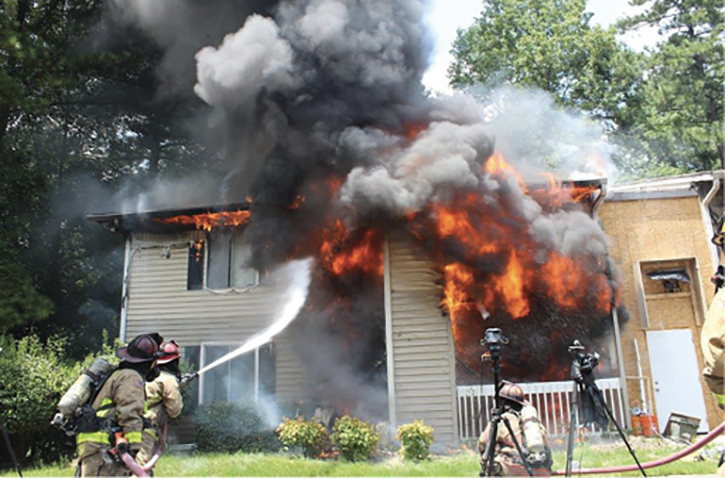
TRAINING NOTEBOOK ❘ By NICK J. SALAMEH
Over time, modern fire science has been providing clarification and new information to the fire service on fire dynamics and proven tactical options. In the progression of this body of work, different words are used to offer context to the discussions. In some cases, new terms are created or old terms are used with different meanings. It’s not very complicated, but some believe it’s a play on words and the only value in creating new terms is a self-fulfilling one to sell more books or to become famous or simply complicate and confuse matters.
Although I can’t rule out those who want to push their self-serving agenda, the Underwriters Laboratories Firefighter Safety Research Institute (UL-FSRI) and the National Institute of Standards and Technology (NIST) scientists and fire service professionals who are at the forefront of modern fire science studies are steadfast in their dedication to firefighter and civilian safety. Their efforts are not to complicate or confuse but rather to clarify, educate, and provide an improved understanding of modern fire dynamics and modern tactics for the safety and benefit of firefighters and civilians.
RELATED FIREFIGHTER TRAINING
Commentary: Why Aren’t More Firefighters Making the Change to Intelligent Firefighting?
Evolution, Not Revolution: Urban Fire Dynamics Boot Camp
Top 3 Tactical Changes from Firefighter Research
There are those who know and understand the value of the studies and those who do not. The latter often argue that the findings describe nothing new, just the same information packaged differently. The fact is that modern fire science has provided beneficial explanations that reaffirm, debunk, or clarify what many of us were taught and believed we knew but may not have fully understood. Fire science discoveries have also brought us to new findings and understandings of things we didn’t know we didn’t know.
The Ever-Changing Landscape
Yesterday’s lessons in fire dynamics and tactics were based on different times that involved different construction materials, methods, and building contents. The fires burned with a lower rate of heat release because of the use of solid woods, cotton, and other Class A materials as opposed to today’s fires, which burn with a higher heat release rate. Among the contributing factors for this higher heat release rate are the growing use of synthetics in building materials and building contents, the use of lightweight engineered wood materials and composites, and more open space/voids in modern lightweight construction. The production of smoke, which is fuel, has also substantially increased in today’s fires as compared to the legacy era. As the fireground evolves, new technology has also evolved to allow scientists the opportunity to observe and record data points like never before.
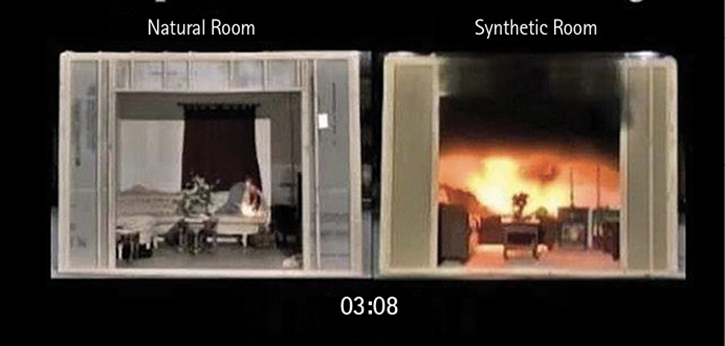
(1) Comparison of room furnishings’ heat release rates. [Photos courtesy of Underwriters Laboratories Firefighter Safety Research Institute (UL-FSRI).]
Explaining these differences through science is impossible to do without words. Words have different meanings and, granted, some words being used to describe findings sound the same as terms to which we’ve been accustomed. However, in some cases, they mean something different. This is required when new discoveries are made and the context of the conversation changes. For instance, the term “indirect attack” means, “Firefighting operations involving the application of extinguishing agents to reduce the buildup of heat released from a fire without applying the agent directly onto the burning fuel.”1 However, it can also mean “a form of fire attack that involves directing fire streams toward the ceiling of a compartment in order to generate a large amount of steam in order to cool the compartment. Converting the water to steam displaces oxygen, absorbs the heat of the fire, and cools the hot gas layer sufficiently for firefighters to safely enter and make a direct attack on the fire.”2 The former is more appropriate to the modern fire conversation, and the latter is more appropriate to what we learned during the “legacy fire” era.
From the Legacy Fire Era to Today
During the legacy fire era, many departments used fog streams. So, when we discussed the indirect attack method at that time, it was focused on inserting the nozzle from an exterior opening like a window to apply a fog stream to the fire compartment to create a significant amount of steam conversion to displace oxygen and cool and smother the fire. Today, many departments use solid and straight streams. So, although the action of an indirect attack is similar, the intention is to direct water into the upper level of the compartment to bank off ceilings and walls to allow the water to coat surfaces. This cools the surfaces and the environment; causes hot gases to contract (a new finding); positively impacts the fire extinguishment process through knockback, fire control, and an immediate reduction in temperatures and the production of smoke; and aids in extinguishment.
The indirect attack mode in the fire service was and still is used as a tool that works effectively when appropriate and applicable. However, our early understanding of this attack mode was about steam production. This practice is best used in structures where no life hazard is present because of the negative effects of steam on potentially savable occupants. At the time, we also believed the fog stream was capable of pushing fire and heat. Fire science has since debunked this thought process and has proven it is the air entrained into the compartment by the fog pattern stream that actually pushes fire and heat. The indirect attack is also not a favorite of some firefighters because the application of water initially begins on the exterior. Nevertheless, it can be highly effective under the right circumstances.
As science indicates, fire cannot differentiate whether the water being applied comes from the interior or exterior, so use an attack method that ensures the fastest most effective water on the fire from the start. It doesn’t necessarily matter where we begin flowing water; it matters where we end up.3 Modern fire science has identified a fire attack method similar to an indirect attack, but it is safer for savable trapped occupants and effective at quickly controlling fire when applicable and appropriate for the fire on which you are working. This method is the transitional attack method.
Studies show that a solid or straight stream held relatively still rather than whipping entrains less air into the fire compartment. Essentially, the water being applied to ceilings and wall surfaces cools, knocks back fire, does not push fire, does not generate large quantities of steam, and causes fire gases to actually contract and vent from the attack window. Water applied to the ceiling and other surfaces maps across those surfaces to create significant cooling. All of these positive reactions translate to quicker fire control and improved interior conditions, which are good for firefighters and savable trapped occupants.
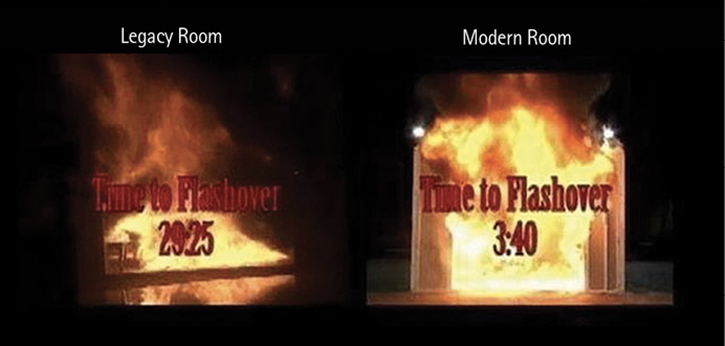
(2) Comparison of room furnishings’ time to flashover.
The transitional attack is a highly effective offensive attack method. It can often provide the quickest, most effective water to the fire area through an open door or window where fire is showing before the first interior line can be placed in service. Transitional attack is intended to be used with a solid or straight stream applied to reachable fire showing from an opening. The solid or straight stream application works best when the stream is applied at a steep angle to the window or door and directed at the ceiling just inside these openings. Unlike the fog pattern, the straight and solid streams allow the stream’s reach to attack fire at higher elevations. The steep angle and water mapping allow the stream to remain highly effective even though the stream is not being applied deep into the opening. To limit air entrainment, hold the stream steady; do not whip it around. The transitional attack is not a one-size-fits-all method—it is an “action of opportunity”4 that has a time and place. It is also one part of the offensive attack mode, meaning an interior line must quickly follow the transitional attack knockback to complete extinguishment; otherwise, regrowth can occur. It’s worth noting that the transitional attack is most effective when considered and used as an initial, proactive action rather than an afterthought. The immediate intention of the transitional attack is to get the fastest water on the fire and into the fire compartment, cool the compartment surfaces to rapidly drop temperatures, improve interior conditions for savable trapped occupants and ahead of the interior attack crew, and prevent the flashover and other trigger events from occurring.
The Attack Modes
Some departments may be familiar with the terms “transitional” and “marginal” attack modes. Our primary fire attack modes are offensive and defensive. When we use the terms “transitional” and “marginal,” they indicate an attack mode in between offensive and defensive. In other words, firefighters will arrive on scene to a fire that can go one way or the other. If the attack mode is not clear-cut based on fire conditions, crews can attempt to begin offensively to see if they can make a positive impact and keep the operation offensive. If not, they could revert to a defensive position. Alternatively, they may begin defensive and gain sufficient control to move to an offensive attack mode.
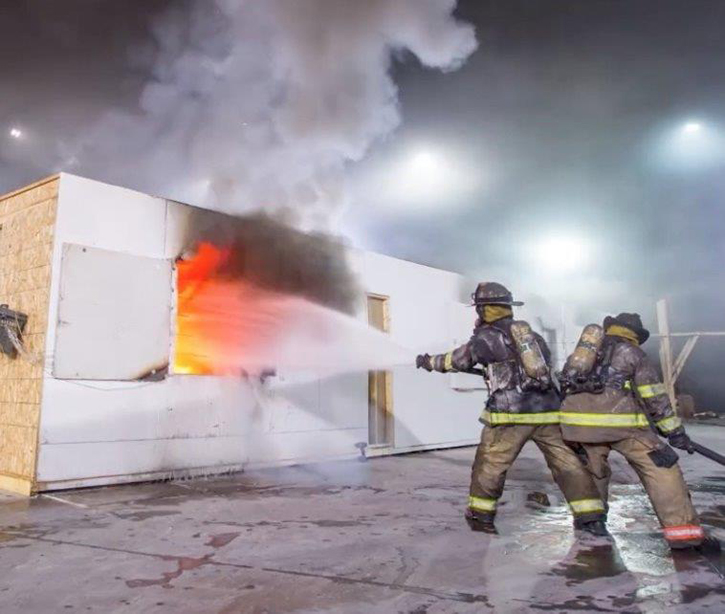
(3) Example of an indirect attack using a fog stream.
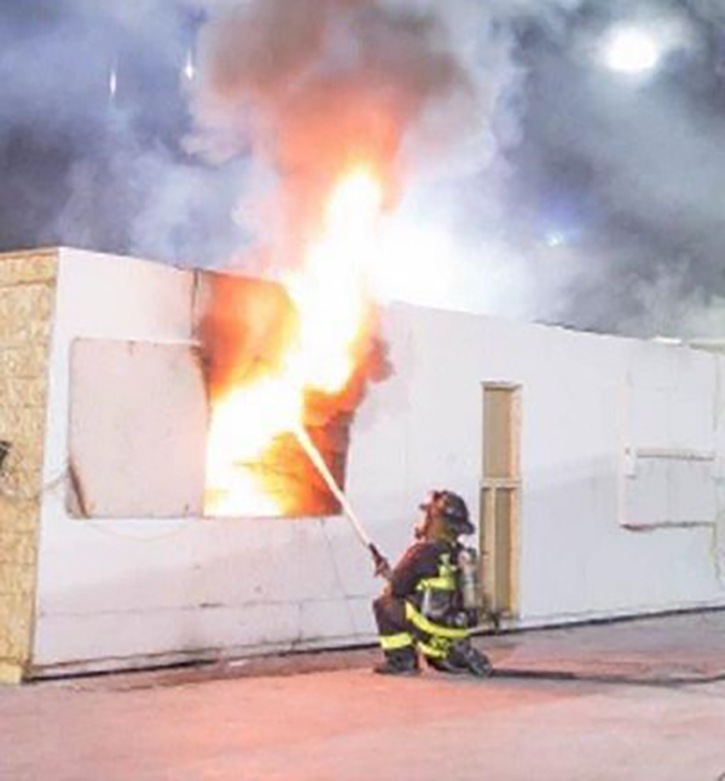
(4) Example of transitional fire attack.
Words can have different meanings based on the context and the agencies defining them. In the fire service, several agencies have similar but different definitions for familiar fire service terms. It’s important to understand the context in which these words are being used. As it relates to attack, the word “transitional” refers to the rapid transition from the initial exterior offensive attack to a rapidly moving interior attack to complete extinguishment and the primary search.
You can execute the transitional attack several ways. The first-arriving engine crew can attack visible fire showing on the exterior from a window or door while the officer completes the 360° size-up. An efficient three-person crew could complete the 360° size-up, attack visible fire, and throw a ground ladder. Of course, crew members must work within their means and abilities and not overextend beyond their primary duties. For rural departments that may operate with one or two members initially, the transitional attack is a great method with which to begin to control fire; improve interior conditions; and, until additional resources arrive, allow for an interior advance.
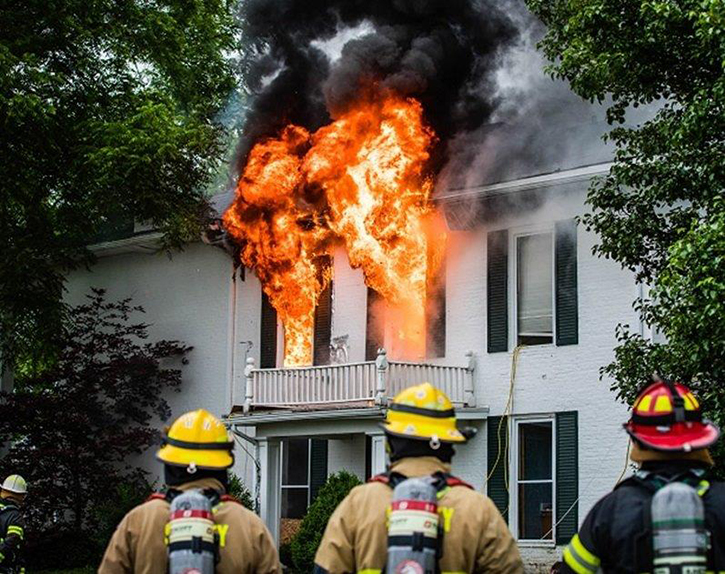
(5) Consider an initial transitional attack and eaves attack to gain knockback, to cool the compartment, and to slow or stop fire travel into the attic through the soffit.
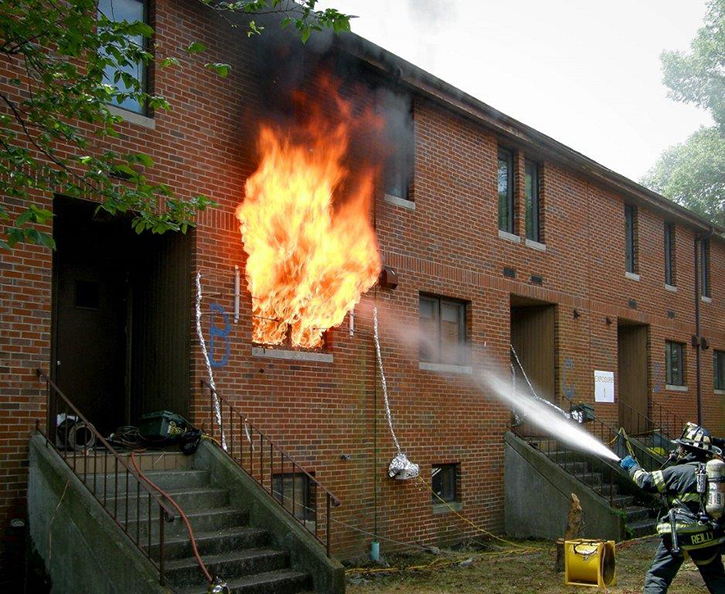
(6) An initial transitional attack can gain an effective knockback on showing fire and stop auto-exposure to floors above and into the attic through the soffit.
Using the transitional attack, you should notice immediate improvement by knocking back flames and cooling and darkening the fire. This is assuming you are properly delivering sufficient water volume from a solid- or straight-stream nozzle from the start. There is no set time for water application, but things should improve within seconds to one minute. You should execute the transitional attack rapidly, so it is critical to select the proper size line from the start.
Sometimes, the two- to 2½-inch handline may be a better option than the traditional 1¾-inch line for added reach and penetration; increased water volume; more effective surface cooling; and the ability to follow up with an eave attack to stop fire extension to the attic or fire travel to upper floors or to protect an adjacent exposure.
With an effective transitional attack, the initial or second crew can then quickly transition to the interior to complete extinguishment and allow for primary duties such as search and rescue to take place in improved conditions. An effective transitional attack buys valuable time while improving interior conditions. Do not consider it a waste of time or delay. If the first and second engine companies arrive at about the same time, it is possible for the first line to begin a transitional attack while the second engine pulls the second hoseline to the interior to complete extinguishment. Alternatively, if the first hoseline goes to the interior and encounters difficulties, the second line can initiate the transitional attack to gain control of the fire and slow its progress. Significantly sized fires may begin with a blitz attack (transitional) to rapidly gain fire control and to lower interior temperatures, allowing attack crews to advance to the interior to complete extinguishment.
Transitional attack can be highly effective at the initial stages of the incident. Many times, we see visible fire continue to grow in size and intensity while the officer completes his 360° size-up. By the time the crew gains entry and advances the line, the fire will have grown significantly in size and heat release. We also see reachable fire showing from openings and rapidly spreading while crews complete gearing up at the front door. What appear to be minimal or ordinary water application delays allow the fire to quickly grow and maintain control. The reality is that one firefighter can begin a transitional attack while the other crew members gear up. Once one firefighter is fully geared, he can take over the line and continue the transitional attack until all firefighters are fully suited up and ready to enter. This results in a significant amount of fire control before entry vs. dealing with a larger, hotter fire on entry. Unchecked heat and gases that continue to generate while firefighters prepare to enter do not improve interior conditions for savable occupants or firefighters. And no water flow on visible reachable fire allows for rapid fire spread inside and outside, which will hamper efforts and negatively impact firefighters and trapped occupants. The longer we allow the fire to be in control, the harder it is for us to gain control. Firefighters must be proactive, not reactive; to do otherwise is to “chase” fire.

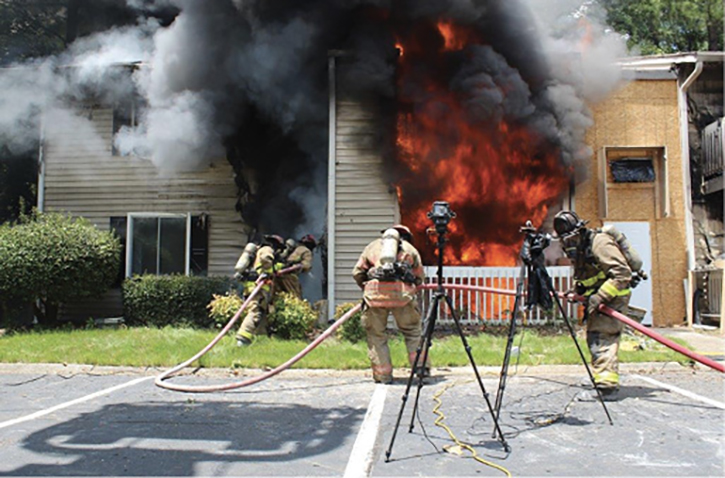
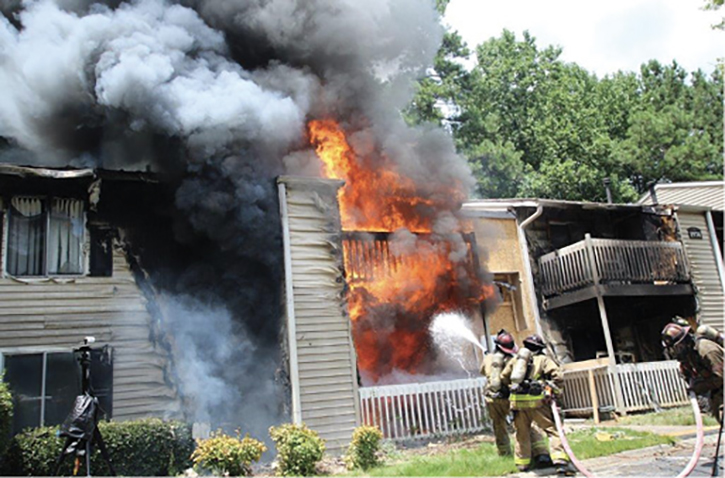

(7-10) An initial exterior offensive attack with a solid or straight stream is versatile because it can attack exterior and interior fire effectively to rapidly gain fire control and improve conditions before crews advance to the interior. This also improves interior conditions for savable trapped occupants. This photo sequence is from the UL-FSRI Analysis of the Coordination of Suppression and Ventilation in Multi-Family Dwellings. The exterior attack sequence was completed in 37 seconds using 94 gallons of water.
You can also apply the transitional attack stream to openings showing high heat and turbulent black smoke (black fire). Doing so rapidly cools and drops temperatures and can often keep a pending flashover or other “trigger” event from occurring. If you can’t make entry quickly and have an opportunity to apply water to visible fire or high-heat areas, consider the transitional attack to rapidly improve interior conditions until a line can advance to the interior.
Regardless of the words we use to describe fire attack methods, fire dynamics, and tactics, it’s more important to know and understand the terms, their context, and how to effectively apply the tactics on the fireground. Some think having more options or tools in the toolbox can confuse and cause operational paralysis, but the reality is that there are not that many choices. The effectiveness comes from knowing and understanding the choices and quickly recognizing which choices are best for the fire on which you’re working.
Words have different meanings. As important as it is to have experience, it’s equally as important to understand the academics of fire science, both the old and the new. After all, becoming firefighters begins with a fire manual. Some of us have seen the meanings of words in these manuals change through the influence of fire science. Our modern fire science manual is an open-ended book that began with the first fire science study and continues to this day. As information is confirmed and clarified, the manual is updated. It’s a dynamic process and should be seen not as an effort to confuse but rather to arm firefighters with the most up-to-date learning and understanding.
Firefighters should consider their training academy learning as a foundation to build on, not to be anchored to. If firefighters fail to remain students of fire dynamics, strategy, and tactics and rely solely on experience, they will limit their evolution and effectiveness as firefighters. Science plays an important role in helping us understand the evolving fireground. Firefighters would be wise to consider the modern fire science studies and to understand the meanings of their words in their proper context.
References
1. National Fire Protection Association Glossary of Terms, 2018 Edition.
2. UL-FSRI. Impact of Fire Attack Utilizing Interior and Exterior Streams on Firefighter Safety and Occupant Survival: Full Scale Experiments.
3. UL-FSRI Analysis of the Coordination of Suppression and Ventilation in Multi-Family Dwellings.
4. Gray S and P.J. Norwood. The Evolving Fireground Research Based Tactics.
NICK J. SALAMEH is a 36-year fire service veteran. He was previously a fire/emergency medical services captain II and training program manager for the Arlington County (VA) Fire Department, where he served 31 years. Salameh is also a former chair of the Northern Virginia Fire Department Training Committee. He is a contributor to Fire Engineering and Stop Believing Start Knowing.

